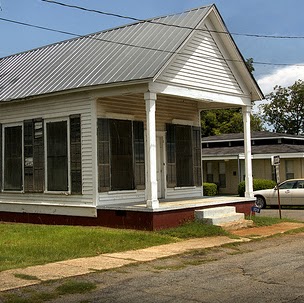Charles E Capps
age ~74
from Mayflower, AR
- Also known as:
-
- Charlotte Capps
Charles Capps Phones & Addresses
- Mayflower, AR
- Jonesboro, AR
- Pleasant Grv, AL
- Kutztown, PA
- Pleasant Grv, AL
Work
-
Company:Abc financial - Sherwood, ARJan 2013
-
Position:Software tester
Education
-
School / High School:University of Massachusetts Lowell- Lowell, MA2012
-
Specialities:Bachelor's in Information Technology
Resumes

Charles Capps
view sourceLocation:
United States

Charles Capps
view sourceLocation:
United States

Charles Capps
view sourceLocation:
United States

Charles Capps
view sourceLocation:
United States

Charles Capps
view sourceLocation:
United States

Charles Capps Little Rock, AR
view sourceWork:
ABC Financial
Sherwood, AR
Jan 2013 to Mar 2014
Software Tester ABC Financial
Sherwood, AR
Mar 2012 to Jan 2013
Help Desk Team Lead Fidelity Information Services
Little Rock, AR
Jul 2011 to Nov 2011
Systems Operation Analyst Cappslite Computing
Little Rock, AR
Aug 2005 to Jul 2011
Self Employed IT Consultant Crews & Associates
Little Rock, AR
Jun 2004 to Jul 2005
Network Support Specialist
Sherwood, AR
Jan 2013 to Mar 2014
Software Tester ABC Financial
Sherwood, AR
Mar 2012 to Jan 2013
Help Desk Team Lead Fidelity Information Services
Little Rock, AR
Jul 2011 to Nov 2011
Systems Operation Analyst Cappslite Computing
Little Rock, AR
Aug 2005 to Jul 2011
Self Employed IT Consultant Crews & Associates
Little Rock, AR
Jun 2004 to Jul 2005
Network Support Specialist
Education:
University of Massachusetts Lowell
Lowell, MA
2012
Bachelor's in Information Technology University of Massachusetts Lowell Lowell
Lowell, MA
2009
Associate's in Information Technology University of Arkansas at Little Rock Writing Center Tutor
Little Rock, AR
2000 to 2002 University of Arkansas at Little Rock Little Rock
Little Rock, AR
1999 to 2002
English Pulaski Academy Little Rock
Little Rock, AR
1999
High School Diploma Pulaski Academy
1999
Business Leaders of America
Lowell, MA
2012
Bachelor's in Information Technology University of Massachusetts Lowell Lowell
Lowell, MA
2009
Associate's in Information Technology University of Arkansas at Little Rock Writing Center Tutor
Little Rock, AR
2000 to 2002 University of Arkansas at Little Rock Little Rock
Little Rock, AR
1999 to 2002
English Pulaski Academy Little Rock
Little Rock, AR
1999
High School Diploma Pulaski Academy
1999
Business Leaders of America
License Records
Charles James Capps Jr
License #:
12344 - Expired
Category:
Chiropractic
Issued Date:
Sep 1, 1949
Expiration Date:
Jan 1, 1901
Isbn (Books And Publications)








Name / Title
Company / Classification
Phones & Addresses
Incorporator
Harris Foods Company, Inc
Mfg Sell Distribute Food Products
Mfg Sell Distribute Food Products
Birmingham, AL
BIOFOAM INDUSTRIES, INC
PEARL MEDICAL SCIENCE, INC
320 Executive Ct SUITE 306, Little Rock, AR 72205
GET IT READY, INC
INTEGRATED CHEMISTRIES, LLC
13821 Pleasant Frst Dr, Little Rock, AR 72212
PERMABOARD INDUSTRIES, INC
11324 Arc Dr , Bay 7, Little Rock, AR 72212
Director, Vice President
F.L. SMIDTH AIRTECH INC
Mfg Blowers/Fans
Mfg Blowers/Fans
3231 Schoenersville Rd, Bethlehem, PA 18017
2040 Ave C, Bethlehem, PA 18017
124 W Capitol Ave SUITE 1900, Little Rock, AR 72201
20410 Ave C, Bethlehem, PA 18017
6102646600
2040 Ave C, Bethlehem, PA 18017
124 W Capitol Ave SUITE 1900, Little Rock, AR 72201
20410 Ave C, Bethlehem, PA 18017
6102646600
Secretary, Principal
HELIX, INC
Nonclassifiable Establishments
Nonclassifiable Establishments
13610 Pleasant Frst Dr, Little Rock, AR 72212
Us Patents
-
Method For Preparing Binder Materials Containing Diisocyanates
view source -
US Patent:6433059, Aug 13, 2002
-
Filed:Oct 18, 1999
-
Appl. No.:09/420012
-
Inventors:Charles L. Capps - Little Rock AR
-
Assignee:Santee, Inc. - Pine Bluff AR
-
International Classification:C09J17500
-
US Classification:524442, 524589, 524789, 524791, 524839, 528 44, 528 48, 528 67, 528905
-
Abstract:A method for preparing a binder material for cellulosic products which comprises providing a polymeric resin base material preferably comprising 4,4â or 2,4â methylene diphenylene diisocyanate in the range of from about 20% to about 55% by weight and a functionality greater than about 2, forming a colloidal gel from silica and a basic solution, and incorporating the colloidal gel into the polymeric base material at a temperature, rate of addition and agitation level to achieve a substantially homogeneous binder material.
-
Dry Process For Bonding Silica-Rich Plant Materials
view source -
US Patent:6610228, Aug 26, 2003
-
Filed:Jan 3, 2001
-
Appl. No.:09/754448
-
Inventors:Charles L. Capps - Little Rock AR
-
Assignee:Santee, Inc. - Pine Bluff AR
-
International Classification:B27N 310
-
US Classification:264109, 264122
-
Abstract:Particles of silica-rich plant material are bonded into a rigid unitary body. The silica content of such materials is believed to enter into bonding reactions when the materials are combined with a polymeric resin base material such as PAPI that has been previously converted by reaction with a colloidal gel formed from silica and a basic solution. The resulting product exhibits characteristics superior to most engineered wood products. A theoretical analysis of the bonding chemistry is proposed.
-
Antifungal Gypsum Board
view source -
US Patent:6680127, Jan 20, 2004
-
Filed:Sep 17, 2002
-
Appl. No.:10/244984
-
Inventors:Charles L. Capps - Little Rock AR
-
Assignee:Temple-Inland Forest Products, Corporation - Diboll TX
-
International Classification:B32B 2900
-
US Classification:4285377, 106 1505, 106 1832, 106 1835, 106778, 106780, 106781, 156 39, 156 44, 162160, 162161, 424413, 424414, 428 70, 4285375, 428907
-
Abstract:A novel gypsum board having antifungal properties is disclosed. The board comprises a gypsum core, front and back paper facings and an antifungal agent effective at inhibiting fungal growth. A preferred antifungal agent is cetylpyridinium chloride. The antifungal agent can be present in the gypsum core and/or on one or both of the paper facings. In addition, the antifungal agent may be encapsulated in a material that releases the antifungal agent over time and/or upon exposure to moisture. Also disclosed are methods for preparing the aforementioned antifungal gypsum board.
-
Antifungal Gypsum Board
view source -
US Patent:6773822, Aug 10, 2004
-
Filed:Aug 1, 2002
-
Appl. No.:10/210680
-
Inventors:Charles Capps - Little Rock AR
-
Assignee:Temple-Inland Forest Products Corporation - Austin TX
-
International Classification:B32B 2900
-
US Classification:4285377, 106 1505, 106 1832, 106 1835, 106778, 106780, 106781, 156 39, 156 44, 162160, 162161, 424413, 424414, 428 70, 4285375, 428907
-
Abstract:A novel gypsum board having antifungal properties is disclosed. The board comprises a gypsum core, front and back paper facings and an antifungal agent effective at inhibiting fungal growth. A preferred antifungal agent is cetyl pyridinium chloride. The antifungal agent can be present in the gypsum core and/or on one or both of the paper facings. In addition, the antifungal agent may be encapsulated in a material that releases the antifungal agent over time and/or upon exposure to moisture. Also disclosed are methods for preparing the aforementioned antifungal gypsum board.
-
Saccharide-Based Resin For The Preparation Of Foam
view source -
US Patent:6846849, Jan 25, 2005
-
Filed:Jan 15, 2003
-
Appl. No.:10/342484
-
Inventors:Charles L. Capps - Little Rock AR, US
-
Assignee:Temple-Inland Forest Products Corporation - Austin TX
-
International Classification:C08J 300
C08K 320
C08L 7500
C08G 1800
C08H 504 -
US Classification:521 841, 5211091, 521137, 521155, 521161, 521170, 521175, 524589, 524590, 524591, 524839, 524840, 527103, 527301, 527401, 528 44, 528 73, 528 76, 528 85
-
Abstract:An embodiment of the present invention includes a foam prepared from a resin comprising: one or more saccharides; one or more isocyanates; one or more resin polyols; and water. The foam may be for example polyurethane foam or polycyanurate foam, either flexible or rigid. Another embodiment includes a method for preparing a foam comprising: forming a resin by mixing one or more saccharides with one or more isocyanates and then mixing the one or more saccharides and the one or more isocyanates with water; and admixing one or more foam polyols to the resin. Another embodiment includes a method for manufacturing a foam derived from an isocyanate, comprising replacing all or a portion of the isocyanate with a resin comprising: one or more saccharides; one or more isocyanates; one or more resin polyols; and water. Another embodiment includes an article of manufacture comprising such foam.
-
Saccharide-Based Resin For The Preparation Of Composite Products
view source -
US Patent:20030134945, Jul 17, 2003
-
Filed:Oct 24, 2002
-
Appl. No.:10/279326
-
Inventors:Charles Capps - Little Rock AR, US
-
International Classification:C08K003/00
C08K003/20 -
US Classification:524/013000, 524/589000
-
Abstract:A novel resin for binding composite lignocellulosic, cellulosic and non-cellulosic products is disclosed. The resin is comprised of one or more isocyanates, one or more saccharides, one or more polyols, and water. Preferaby, the saccharide is a polysaccharide comprised of corn syrup. Preferably, the isocyanate is a polyisocyanate and the polyol is an ethylene glycol. Also disclosed are methods for preparing and applying the resin as well as the products prepared from the resin.
-
Virucidal Activities Of Cetylpyridinium Chloride
view source -
US Patent:20050100601, May 12, 2005
-
Filed:Nov 7, 2003
-
Appl. No.:10/703969
-
Inventors:Charles Capps - Little Rock AR, US
-
Assignee:ViraTox, L.L.C. - Little Rock AR
-
International Classification:A61K033/32
A61K031/44
A61K009/22 -
US Classification:424468000, 514358000, 424641000
-
Abstract:This disclosure relates to inventive methods for inactivating viral pathogens in which the steps of the methods include: (a) providing a virucidal composition comprising a liquid media containing less than 1% weight per volume cetylpyridinium chloride; and (b) contacting the virucidal composition with a surface targeted for disinfection. This disclosure further relates to inventive virucidal compositions, in which the compositions include: (a) a liquid media; (b) cetylpyridinium chloride in solution in the liquid media at a concentration of less than 1% weight per volume; (c) an extender; and (d) an enhancer.
-
Virucidal Activities Of Cetylpyridinium Chloride
view source -
US Patent:20050100612, May 12, 2005
-
Filed:Sep 10, 2004
-
Appl. No.:10/939307
-
Inventors:Charles Capps - Little Rock AR, US
-
Assignee:ViraTox, L.L.C. - Little Rock AR
-
International Classification:A61K031/44
A61K033/32 -
US Classification:424641000, 514358000
-
Abstract:This disclosure relates to inventive methods for inactivating viral pathogens in which the steps of the methods include: (a) providing a virucidal composition comprising a liquid media containing less than 1% weight per volume cetylpyridinium chloride; and (b) contacting the virucidal composition with a surface targeted for disinfection. This disclosure further relates to inventive virucidal compositions, in which the compositions include: (a) a liquid media; (b) cetylpyridinium chloride in solution in the liquid media at a concentration of less than 1% weight per volume; (c) an extender; and (d) an enhancer.
Plaxo

Capps, Charles
view sourceUNC Hospitals

Charles Capps
view sourceDirector, Manufacturing Operations at ETEX
Classmates

Charles Capps
view sourceSchools:
Workman High School City Of Industry CA 1966-1970
Community:
Cathy Adams, Chris Derry

Charles Capps
view sourceSchools:
Tiptonville High School Tiptonville TN 1968-1972
Community:
Randy Turnage, Pam Crittenden

Charles Capps
view sourceSchools:
Bladensburg High School Bladensburg MD 1966-1970
Community:
David Mumper, Donna Abbott, Florence Abel, Ingrid Mcclam, Duane Allen

Charles Capps
view sourceSchools:
Blountstown High School Blountstown FL 1980-1984
Community:
Derry Bowden, Pat Perkins, William Mcnew

Charles Capps
view sourceSchools:
East Wake High School Wendell NC 1975-1979
Community:
Jim Reece, David Ange, Ernest King

Charles Capps
view sourceSchools:
Gray High School Idabel OK 1951-1955
Community:
Alene Bates, Sue Lindsey, Boyd Warren, Barbara Pollard, Lonzie Washingston, Merrill Harkey, Yvonne Burns, Betty Cobb, Carol Ray, Lona Eads

Charles Capps, Central Hi...
view source
Tiptonville High School, ...
view sourceGraduates:
Charles Capps (1968-1972),
Mary Mathis (1961-1965),
Junior Collins (1974-1978),
George Ashley (1945-1949)
Mary Mathis (1961-1965),
Junior Collins (1974-1978),
George Ashley (1945-1949)
Youtube
Myspace
Googleplus

Charles Capps
Work:
Silicon Mechanics - IT Manager (2011)
Silicon Mechanics - Lead Developer (2006-2011)
Infopop - Perl Developer (2001-2006)
Silicon Mechanics - Lead Developer (2006-2011)
Infopop - Perl Developer (2001-2006)

Charles Capps

Charles Capps

Charles Capps

Charles Capps

Charles Capps

Charles Capps
view source
Charles Capps
view source
Charles Charlie Capps
view source
Charles Michael Capps
view source
Charles Capps
view source
Charles Capps
view source
Charles Tyler Capps
view source
Charles Capps
view sourceFlickr
Get Report for Charles E Capps from Mayflower, AR, age ~74


















